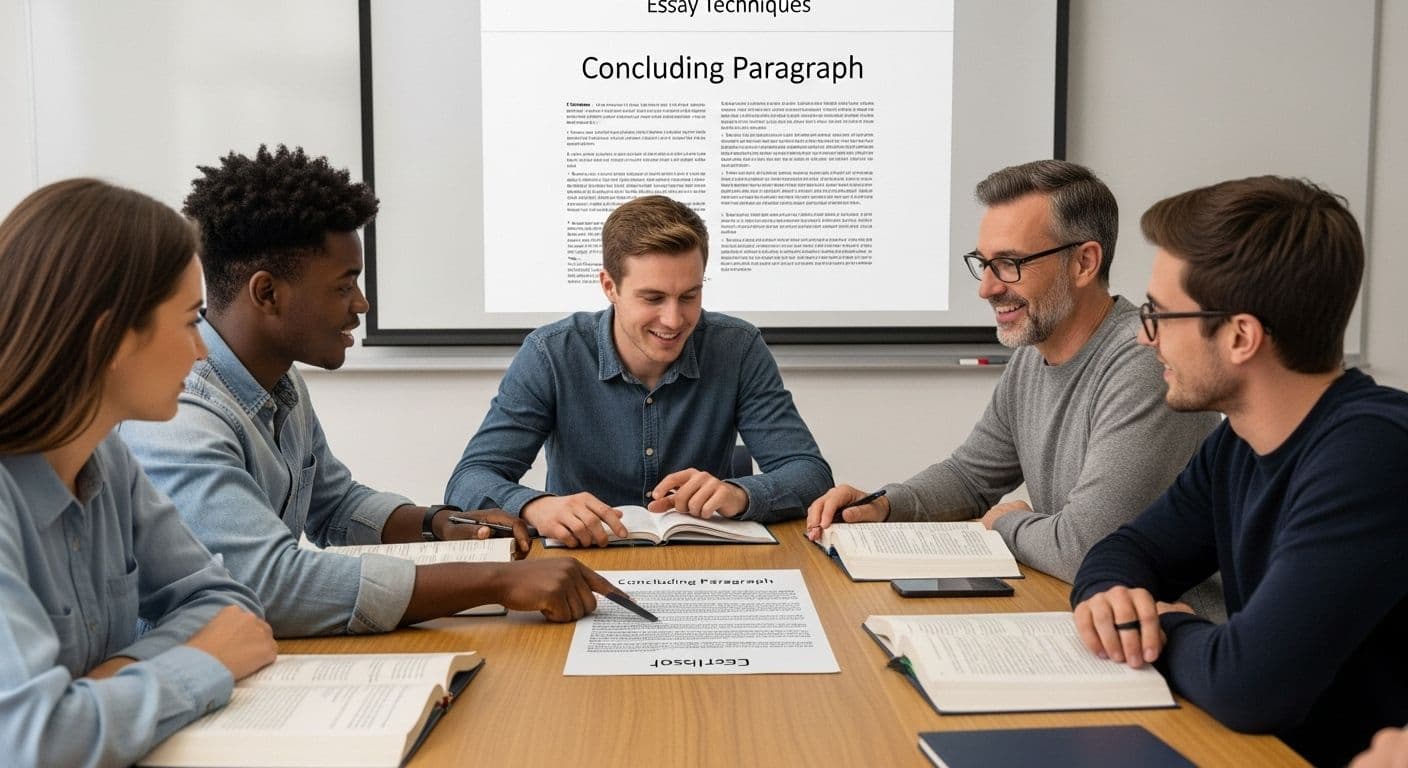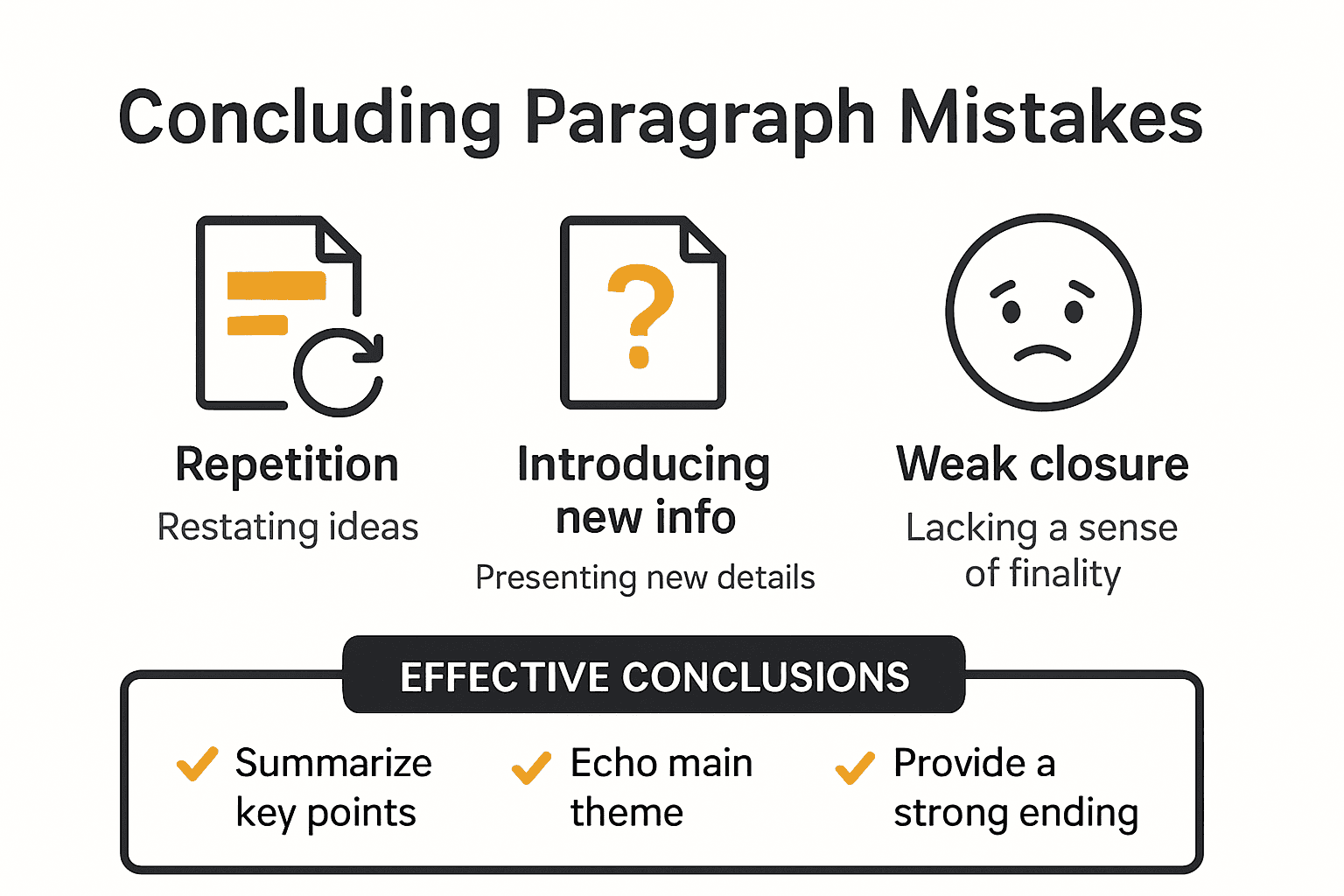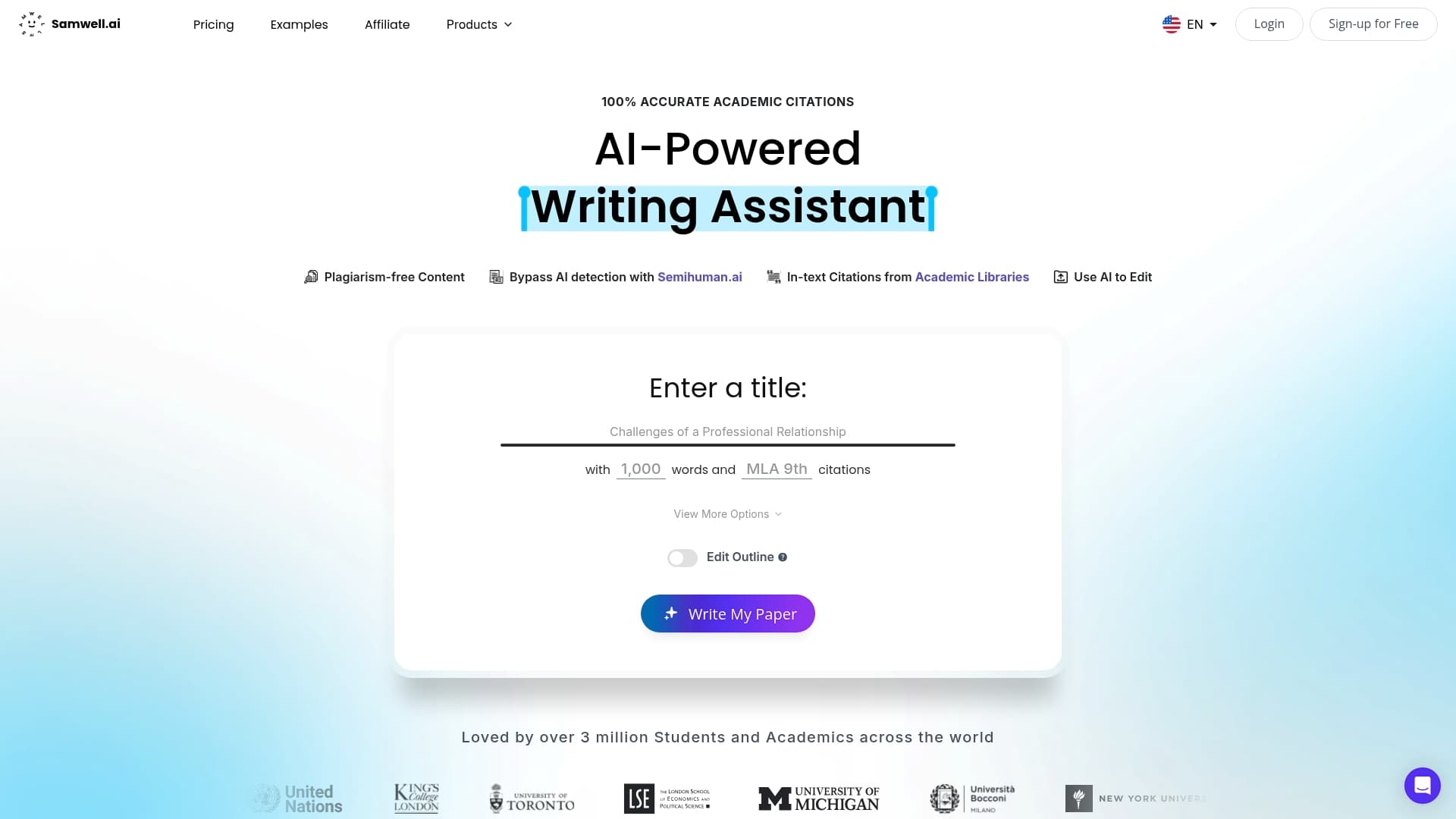Blog
Learning Materials
How to Write a Strong Concluding Paragraph Easily
Updated: August 12, 2025

A good essay can fall flat if the conclusion fails to deliver. Even though over 70 percent of students admit to rushing through their closing paragraph and losing points as a result, most still see it as just a quick summary. Oddly enough, the real purpose of a conclusion is not about wrapping things up at all. It is your last shot to synthesize your argument and leave the reader thinking long after they have finished reading.
Table of Contents
- Understanding The Role Of A Concluding Paragraph Dockerfile README.md email-templates i18n-config.ts i18nConfig.ts next-sitemap-samwell.config.js next-sitemap-semihuman.config.js next.config.js node_modules package-lock.json package.json process_content.js public scripts src svgr.d.ts translations tsconfig.json The Purpose And Strategic Importance Of Conclusions Dockerfile README.md email-templates i18n-config.ts i18nConfig.ts next-sitemap-samwell.config.js next-sitemap-semihuman.config.js next.config.js node_modules package-lock.json package.json process_content.js public scripts src svgr.d.ts translations tsconfig.json Psychological Impact Of An Effective Conclusion
- Essential Elements To Include For Impact Dockerfile README.md email-templates i18n-config.ts i18nConfig.ts next-sitemap-samwell.config.js next-sitemap-semihuman.config.js next.config.js node_modules package-lock.json package.json process_content.js public scripts src svgr.d.ts translations tsconfig.json Restating The Thesis With Fresh Perspective Dockerfile README.md email-templates i18n-config.ts i18nConfig.ts next-sitemap-samwell.config.js next-sitemap-semihuman.config.js next.config.js node_modules package-lock.json package.json process_content.js public scripts src svgr.d.ts translations tsconfig.json Synthesizing Key Arguments Dockerfile README.md email-templates i18n-config.ts i18nConfig.ts next-sitemap-samwell.config.js next-sitemap-semihuman.config.js next.config.js node_modules package-lock.json package.json process_content.js public scripts src svgr.d.ts translations tsconfig.json Providing Forward-Looking Perspective
- Step-By-Step Guide To Writing Your Conclusion Dockerfile README.md email-templates i18n-config.ts i18nConfig.ts next-sitemap-samwell.config.js next-sitemap-semihuman.config.js next.config.js node_modules package-lock.json package.json process_content.js public scripts src svgr.d.ts translations tsconfig.json Preparing The Groundwork Dockerfile README.md email-templates i18n-config.ts i18nConfig.ts next-sitemap-samwell.config.js next-sitemap-semihuman.config.js next.config.js node_modules package-lock.json package.json process_content.js public scripts src svgr.d.ts translations tsconfig.json Structuring The Concluding Paragraph Dockerfile README.md email-templates i18n-config.ts i18nConfig.ts next-sitemap-samwell.config.js next-sitemap-semihuman.config.js next.config.js node_modules package-lock.json package.json process_content.js public scripts src svgr.d.ts translations tsconfig.json Refining And Polishing
- Common Mistakes And How To Avoid Them Dockerfile README.md email-templates i18n-config.ts i18nConfig.ts next-sitemap-samwell.config.js next-sitemap-semihuman.config.js next.config.js node_modules package-lock.json package.json process_content.js public scripts src svgr.d.ts translations tsconfig.json Repetition And Redundancy Traps Dockerfile README.md email-templates i18n-config.ts i18nConfig.ts next-sitemap-samwell.config.js next-sitemap-semihuman.config.js next.config.js node_modules package-lock.json package.json process_content.js public scripts src svgr.d.ts translations tsconfig.json Introducing New Information Inappropriately Dockerfile README.md email-templates i18n-config.ts i18nConfig.ts next-sitemap-samwell.config.js next-sitemap-semihuman.config.js next.config.js node_modules package-lock.json package.json process_content.js public scripts src svgr.d.ts translations tsconfig.json Weak And Ineffective Closure
Quick Summary
| Takeaway | Explanation |
|---|---|
| Conclusions should synthesize key points | An effective conclusion connects the main arguments and demonstrates their collective significance to reinforce the thesis. |
| Restate the thesis with new insights | Avoid simply repeating the thesis; instead, reframe it to show intellectual growth and the evolution of your argument. |
| Include a forward-looking perspective | Engage readers by suggesting future implications or research areas, transforming your conclusion into an active intellectual prompt. |
| Avoid introducing new information | A conclusion should synthesize existing ideas rather than presenting new concepts, maintaining coherence and clarity for the reader. |
| Ensure a sense of closure | A successful conclusion provides a feeling of completeness and connects the specific argument to broader contexts, leaving a lasting impression on readers. |
Understanding the Role of a Concluding Paragraph
A concluding paragraph serves as the critical final segment of an academic or professional document, functioning far beyond a simple summary. This strategic section represents the writer's ultimate opportunity to synthesize key arguments, demonstrate the broader significance of their work, and leave a lasting intellectual impression on readers.
The Purpose and Strategic Importance of Conclusions
Writers often misunderstand the concluding paragraph as merely a repetitive summary. However, our comprehensive writing guide reveals a more nuanced approach. According to the University of North Carolina at Chapel Hill Writing Center, a powerful concluding paragraph accomplishes multiple sophisticated objectives:
- Synthesize Core Arguments: Integrate the primary points discussed throughout the document, showing how individual ideas interconnect and support the central thesis.
- Demonstrate Significance: Explain why the arguments matter beyond the immediate context, highlighting broader implications or potential future research directions.
- Create Intellectual Closure: Provide a sense of completeness that signals the logical resolution of the discussion.
Psychological Impact of an Effective Conclusion
The concluding paragraph operates as a final intellectual touchpoint between the writer and reader. Its composition can dramatically influence the audience's perception of the entire document. A well-crafted conclusion transforms a collection of paragraphs into a cohesive, memorable intellectual experience.
Effective conclusions transcend simple restating of information. They synthesize complex ideas, demonstrate critical thinking, and invite readers to contemplate the broader context of the research or argument. By strategically connecting individual points and revealing their collective significance, writers can transform a standard document into a compelling intellectual narrative.
Understanding the nuanced role of a concluding paragraph requires recognizing it as more than a perfunctory wrap up. It represents the writer's final opportunity to demonstrate intellectual depth, analytical sophistication, and the broader relevance of their work. Whether in academic research, professional reports, or persuasive essays, a strategically constructed concluding paragraph can elevate the entire document's impact and memorability.
Essential Elements to Include for Impact
Crafting a powerful concluding paragraph requires strategic incorporation of specific elements that elevate the entire document's intellectual impact. While many writers approach conclusions mechanically, the most effective paragraphs are carefully constructed to provide meaningful closure and lasting intellectual resonance.
Restating the Thesis with Fresh Perspective
A critical component of an impactful concluding paragraph involves reimagining the thesis statement. Learn more about crafting compelling essay structures, as simply repeating the original thesis verbatim diminishes the paragraph's potential. According to the University of North Carolina at Chapel Hill Writing Center, the thesis should be reframed in a way that demonstrates how the argument has evolved through the document's exploration.
- Contextual Reframing: Present the original thesis from a broader or more nuanced perspective
- Evolutionary Insight: Show how the argument has deepened or transformed through analysis
- Intellectual Growth: Highlight the journey of understanding achieved through the document
Synthesizing Key Arguments
Effective concluding paragraphs go beyond simple summarization. They synthesize the document's core arguments, revealing their interconnectedness and collective significance. This approach transforms a mechanical recap into an intellectual narrative that demonstrates the depth and complexity of the writer's thinking.
Successful synthesis involves:
- Identifying the most critical points discussed
- Showing how these points relate to and support the central thesis
- Revealing the broader implications of the collective arguments
Providing Forward-Looking Perspective
The most memorable concluding paragraphs do more than reflect on what has been discussed. They invite readers to consider future implications, potential research directions, or broader contextual significance. This forward-looking approach transforms the conclusion from a passive summary into an active intellectual provocation.
Strategic forward-looking elements include:
- Suggesting potential areas for future research
- Highlighting the broader societal or academic implications of the arguments
- Posing thought-provoking questions that extend the document's intellectual exploration
A truly impactful concluding paragraph serves as more than a formal ending. It represents the writer's final opportunity to demonstrate intellectual sophistication, synthesize complex ideas, and leave a lasting impression on the reader. By carefully integrating these essential elements, writers can transform a standard conclusion into a powerful intellectual statement that resonates well beyond the immediate document.

Step-by-Step Guide to Writing Your Conclusion
Below is a process table outlining the structured steps involved in writing a strong concluding paragraph, summarizing the 'Step-by-Step Guide to Writing Your Conclusion' section for easy reference.
| Step | Actions Involved |
|---|---|
| Preparing the Groundwork | Review thesis, identify key arguments, analyze the document's arc, determine broader implications |
| Structuring the Conclusion | Restate thesis (reimagined), synthesize key points, add a forward-looking perspective |
| Refining and Polishing | Read aloud for flow, ensure completeness, remove redundancy, confirm added value beyond repetition |
Crafting an exceptional concluding paragraph requires a systematic approach that transforms complex ideas into a powerful final statement. Explore advanced academic writing techniques to elevate your writing skills and understand the nuanced process of constructing a compelling conclusion.
Preparing the Groundwork
Before drafting the conclusion, writers must conduct a strategic review of their entire document. According to the University of North Carolina at Chapel Hill Writing Center, effective conclusions demand careful preparation and intentional reflection.
Key preparation steps include:
- Reviewing the original thesis statement
- Identifying the most significant arguments presented
- Analyzing the overall narrative arc of the document
- Determining the broader implications of the research or argument
Structuring the Concluding Paragraph
A well-constructed concluding paragraph follows a deliberate structural approach. Professional writers understand that the conclusion is not a simple summary but a sophisticated intellectual synthesis. The structure typically involves three critical components:
- Restatement of Thesis: Reimagine the original thesis, presenting it from a more nuanced perspective
- Synthesis of Key Arguments: Connect the primary points in a manner that reveals their collective significance
- Forward-Looking Perspective: Extend the intellectual conversation beyond the immediate document
Refining and Polishing
The final stage of writing a concluding paragraph involves meticulous refinement. Writers must critically evaluate their conclusion, ensuring it provides intellectual closure while inviting further contemplation. This process requires careful attention to language, tone, and overall impact.
Refinement strategies include:
- Reading the conclusion aloud to assess its rhythm and flow
- Ensuring the paragraph provides a sense of completeness
- Verifying that the conclusion adds value beyond simple repetition
- Eliminating unnecessary words or redundant phrases
Successful concluding paragraphs transcend mechanical writing techniques. They represent a writer's intellectual sophistication, demonstrating the ability to synthesize complex ideas and leave a lasting impression. By following this systematic approach, writers can transform their conclusions from routine summaries into powerful intellectual statements that resonate with readers long after the document is complete.
Remember that a truly exceptional concluding paragraph is not an afterthought but a strategic opportunity to showcase the depth and breadth of your intellectual argument. Each word should be carefully chosen to maximize impact, providing a memorable final perspective that elevates the entire document.
Common Mistakes and How to Avoid Them
Writing a compelling concluding paragraph requires nuanced skill and careful strategy. Many writers inadvertently undermine their entire document by making critical errors in their final paragraph. Learn advanced writing techniques to elevate your academic writing and avoid these common pitfalls.

Repetition and Redundancy Traps
One of the most prevalent mistakes writers make is simply restating their thesis or arguments verbatim. According to the University of North Carolina at Chapel Hill Writing Center, effective conclusions should synthesize ideas rather than mechanically repeat them.
Common repetition errors include:
- Copying the thesis statement word-for-word
- Listing arguments already discussed in detail
- Using identical language from earlier sections
- Failing to provide new insight or perspective
To avoid these traps, writers must:
- Reframe the thesis from a broader perspective
- Highlight the evolution of the argument
- Introduce fresh analytical insights
- Demonstrate intellectual growth through the document
Introducing New Information Inappropriately
Another critical mistake is introducing substantial new information in the concluding paragraph. The conclusion should synthesize existing arguments, not present entirely new concepts that require extensive explanation. This approach can confuse readers and disrupt the document's coherence.
Strategies to prevent inappropriate information introduction:
- Reserve complex new ideas for the body paragraphs
- Use the conclusion to connect existing arguments
- Focus on synthesizing and interpreting known information
- Provide broader context for existing arguments
Weak and Ineffective Closure
The table below summarizes common mistakes writers make in concluding paragraphs and strategies, already discussed in the article, for avoiding each pitfall.
| Common Mistake | Description | How to Avoid |
|---|---|---|
| Repetition and Redundancy | Restating thesis or arguments verbatim without new insight | Reframe thesis, highlight argument evolution |
| Introducing New Information | Adding substantial new concepts in the conclusion | Focus on synthesizing existing arguments |
| Weak and Ineffective Closure | Abrupt or vague ending lacking a sense of resolution | Provide completeness, connect to broader context |
Many writers struggle with creating a strong, memorable conclusion. Weak conclusions often feel abrupt, disconnected, or anticlimactic. They fail to provide the intellectual closure that transforms a good document into an exceptional one.
Characteristics of ineffective conclusions include:
- Ending without a clear sense of resolution
- Using vague or generic language
- Failing to demonstrate the broader significance of the argument
- Leaving readers without a lasting intellectual impression
To craft a powerful conclusion, writers must:
- Provide a sense of completeness
- Connect the specific argument to broader contexts
- Use precise, meaningful language
- Create a final statement that resonates intellectually
A truly exceptional concluding paragraph is an art form. It requires writers to balance synthesis, insight, and forward-looking perspective. By avoiding these common mistakes, writers can transform their conclusions from perfunctory summaries into powerful intellectual statements that extend the conversation beyond the immediate document.
Frequently Asked Questions
What is the main purpose of a concluding paragraph?
The main purpose of a concluding paragraph is to synthesize the key arguments made in the document, demonstrate their significance, and provide a sense of intellectual closure to the reader. It should leave a lasting impression and encourage future contemplation on the topic.
How can I avoid repetition in my conclusion?
To avoid repetition, reframe your thesis and arguments rather than repeating them verbatim. Integrate insights gained during your research, highlight the evolution of your argument, and focus on synthesizing key points instead of merely summarizing them.
What should I include to create a forward-looking perspective in my conclusion?
To create a forward-looking perspective, you can suggest potential areas for future research, highlight broader societal implications, or pose thought-provoking questions that extend the conversation beyond your document.
What common mistakes should I avoid when writing my conclusion?
Common mistakes include introducing new information, repeating arguments without adding insight, and creating a weak closure. Make sure to synthesize existing information and provide a clear sense of completeness that resonates with readers.
Transform Your Essay Conclusions With Samwell.ai
Struggling to craft a memorable concluding paragraph that truly resonates? Many readers of this article have felt the frustration of repetitive endings or a lack of intellectual closure. You already know that a great conclusion should synthesize your key arguments and provide forward-looking perspective, but the pressure to get it just right can take away your confidence and slow down your writing process.

Samwell.ai can help you overcome these hurdles instantly. With features like the Power Editor and Guided Essays, you can restate your thesis with a fresh voice, synthesize arguments with clarity, and highlight future research directions without any risk of redundancy or weak closure. Join over a million academics who trust Samwell.ai for AI-driven writing support that blends efficiency with academic integrity. Visit our home page to start writing stronger conclusions, get real-time guidance, and transform your academic papers today.
Recommended
- How to structure an essay | Quick and effective guide
- "How to write an essay | Clear, step-by-step guidance
Generate essays with Samwell.ai
Whether you’re a publisher, professor, journalist, or student, let us tailor a plan just for you.Most Read Articles

Your Guide to Help Writing a Essay Successfully
Expert tips for help writing a essay - from crafting a thesis to structuring your essay effectively.

How to Write Critical Thinking Essay: Expert Tips
Expert tips for writing a critical thinking essay. Learn how to structure, choose topics, and use evidence effectively.'

How to Write a Good Hook: A Step-by-Step Guide
Master the art of crafting a good hook with our guide. Create compelling openers for a memorable first impression.
